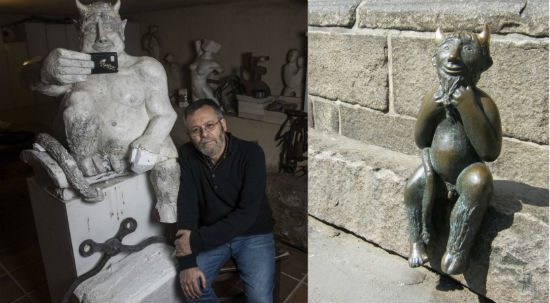Here’s a charming little folktale from Lübeck, Germany, involving St. Mary’s Church, which was built from 1250 to 1350 and features the tallest brick vault in the world:
When the Gothic-style St Mary’s Church was being built in Lübeck in the mid-13th century, local legend has it that none other than Satan himself stopped by the construction site to see what was afoot. The workers, scared to tell him the truth, told the devil they were building a magnificent wine bar. The devil was so excited to have some more souls come his way, he began to lend a hand with the construction.
As the legend goes, it was only when the basilica was nearly finished that the prince of darkness realized he had been tricked. In his rage, he picked up a large slab to destroy the church, but a quick-thinking laborer promised him that they would build a wine bar in the same neighborhood. This pacified the devil, who dropped the slab right near the church.
The slab still remains at that spot, with markings that are supposedly the claw marks of the devil, and is called the “Devil’s Stone.” To honor the legend, a bronze statue of the devil designed by Rolf Goerler was placed on the slab in 1999. He looks quite pleased with the way things turned out and smiles cheekily at passers-by. The people of Lübeck also kept their word, and built the Ratskeller tavern across the road from the church.
St. Mary’s is a Catholic church, but the compromise agreed to at the end of that story still has a whiff of Lutheran Two Kingdoms theology to it. Despite that, I really like this story.
Turns out there’s a similar legend in Segovia, Spain, claiming that the city’s spectacular first-century aqueduct was not built by the Romans, but by the devil Mephistopheles who was tricked into doing it by a crafty servant girl who was tired of hauling water every day.

With an eye toward the tourists who boost the ancient city’s economy, Segovia planned a statue of its own to commemorate the legend:
But the move has brought controversy with it: the complaints from local residents have seen the installation work halted by a judge.
The 1.7-meter sculpture depicts a smiling devil, who has a cellphone in one hand and is taking a selfie. … But the final installation will have to wait until a Segovia court rules whether the statue constitutes an attack on religious sentiments, as a group of local residents have denounced. …
“It all began with a visit to Lübeck,” explains José Antonio Abella, the creator and donator of the statue. “They also have a local legend about the devil being duped into building a church. When I saw the little figure they had there as a tribute, I thought, ‘What a great idea to export to Segovia!’”
A sculptor and a writer, the retired country doctor was born in Burgos 63 years ago, but says that he is Segovian by adoption. The row that has broken out over his creation has taken him by surprise. “I don’t understand anything,” he says, with sadness. “I just wanted to pay homage to my city and to create something to give back all I have been given.”
The faux-pious “religious” objection to this statue is strained, to say the least. Their claim — that the devil “is offensive for Catholics, because it constitutes the glorification of evil” — is preposterous. This is Segovia, a city whose Catholic patroness is the Virgin of Fuencisla, a statue of whom sits in the center of the famous aqueduct — in the empty space that legend says marks the spot where the devil failed to place the final rock of the aqueduct, thereby losing his bet with the servant girl that he could finish building it before morning. And in some versions of the legend, it was the appearance of the virgin in that very spot that stayed the devil’s hand, thus sparing the girl’s soul.
The story shouldn’t be “offensive for Catholics” in Segovia. The story has shaped Catholics in Segovia.
The story also has nothing to do with the “glorification of evil.” It’s a story about the defeat of evil — through pluck, luck, cunning, and maybe a bit of divine intervention.
Abella’s devil is a good sport about it. Like the grinning imp outside of St. Mary’s in Lübeck, he seems to have accepted his loss in good humor.
To be fair, it’s understandable that the uptight takers of offense in Segovia would have a hard time distinguishing between the genie-like trickster figure in the folktale and the godlike personification of evil in their dogma. The former, older character is, after all, the main basis for the creation of the latter one.
But then these sanctimonious opponents of whimsy aren’t really taking their stand in opposition to either of those characters. Like most people portraying themselves as guardians against the devil himself, they’re mainly concerned with being perceived as such. They’re concerned, in other words, with pretending to be opposed to superlative evil so that they, by contrast, can claim to be superlative good.
That’s the pose that C.S. Lewis said would “make us into devils.” This, too, has a long history there in Segovia, as Abella notes:
“It’s insane,” adds sculptor José Antonio Abella, who points out with a hint of irony that this Mephistopheles is going to be installed next to the former headquarters of the Spanish Inquisition in the city. “It would appear that the inquisitors never left the country for good,” he concludes.










